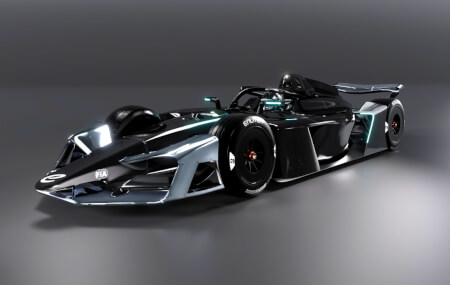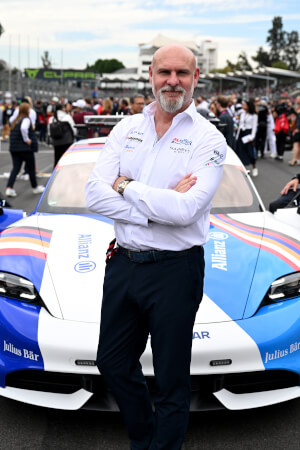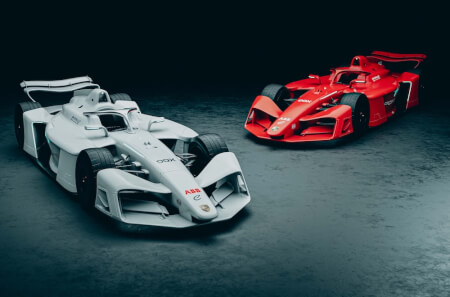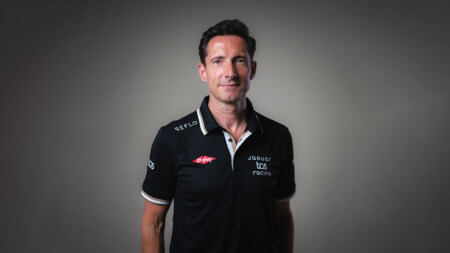November 5th 2025
Formula E reveals Gen 4 car
Formula E has unveiled its new GEN4 racing car, the series’ fastest, most powerful car yet, which will debut next year.
Capable of well over 200 mph and delivering 50 percent more power than the current GEN3 Evo machine – 600kW, the equivalent of 815 hp, in Attack Mode and qualifying, increasing to 700kW with regenerative braking, and the standard race output being 450kW) – the new car also features permanent all-wheel-drive and an active differential.
It is also Formula E's most sustainable car ever, made from 100 percent recyclable materials and made up of at least 20 percent recycled materials, with every component in the car coming from "ethical" sources, according to the series.
“In just 12 years, to come from where we were in the Generation 1 car, flicking between two cars halfway through the race with a top speed of about 140 mph, It feels almost inconceivable that we're about to launch this incredible vehicle into the ecosystem,” said Formula E CEO Jeff Dodds. “This is our most advanced, most complex car ever created, and from a driving point of view, will be the most complex car that any Formula E driver has ever sat in. It's very exciting.
“In just 12 years, to come from where we were in the Generation 1 car, flicking between two cars halfway through the race with a top speed of about 140 mph, It feels almost inconceivable that we're about to launch this incredible vehicle into the ecosystem,” said Formula E CEO Jeff Dodds. “This is our most advanced, most complex car ever created, and from a driving point of view, will be the most complex car that any Formula E driver has ever sat in. It's very exciting.
“The car is so much more menacing than anything we've ever put on track before. Formula E is close combat racing in these beautiful, little, agile cars, whereas here you have a car with much more presence, a much bigger footprint and much more power. So if we can combine this new car with the same style of close combat racing, I think we're in for something incredibly special over the coming years.”
The GEN4 features improved aerodynamics, with two distinct configurations – high downforce, which will be utilized in qualifying, and a low-downforce setup designed for race conditions. And despite the focus on aero performance, Formula E’s trademark close racing – something of a byproduct of previous cars’ more modest aero approaches – is expected to remain according to Marek Nawarecki, senior circuit sport director at the FIA.
“Aerodynamics in racing are very important, and we decided to to be more performant on this aspect which will improve and the handling of the car, the way that the car behaves on the track, the speed in the corners, and will have a lot of impacts in the outcome from the from the racing end of the show,” he said.
“Aerodynamics in racing are very important, and we decided to to be more performant on this aspect which will improve and the handling of the car, the way that the car behaves on the track, the speed in the corners, and will have a lot of impacts in the outcome from the from the racing end of the show,” he said.
“The development of the aero is always a compromise because it affects the way that the driver will handle the car a lot. What is important to understand is that it is a combination of two parameters: the increase of the power, the increase of the traction, because we will have permanent four-wheel-drive, and the aerodynamics coming on top of that.
“We had to increase the downforce and to find the right performance window in terms of the drag. So the target in that area has been set at a slightly different level than it was for the previous generation of the car with less power.
“I think that with this level of power, for the drivers, this car will be even more challenging. So we will have a lot of challenges already for the drivers to manage the car. And we think that even with the more aero efficiency, we will have very good racing.
“We will probably see more aerodynamic effects compared to the previous generation, related with the speed, with the slipstreaming effect and so for sure, the perception of the racing differs compared to the current generation of the car.”
The new aero profile gives the car a more conventional look compared to previous Formula E cars, but Nawarecki says that hasn’t been a deliberate decision to make the car more appealing to a wider audience, but rather a function-over-form approach.
“Our intention was not to be partially inspired with any other existing design of the cars in different categories,” he said. “It was really the exercise to design the car which will match the expectation in terms of dynamics, aerodynamics and the parameters. It was designed for this fourth generation and to match the expectations and parameters in terms of array dynamics.
Dodds added, “Other series have been iterating their aerodynamics to within an inch of its life to extract every tiny nuance of performance out of the car, and when the FIA and their partners set out to build a fast car, it's no surprise you end up in a similar space, because that's what that's the most aerodynamically performant car you can create. They all look quite similar.
“But I think for a lot of motorsport loyalists and fans, it was so different in the way that it looked that maybe it was too big a jump for them to go on the journey. And I think you definitely don't get that with a GEN4 car, it looks awesome and mean, but it looks within the framework of what you expect a racing car to look like.”
In testing, the car has already completed the equivalent of more than the full distance of pre-season testing and all races during a season – primarily in the hands of former Formula E driver and Formula 1 test driver James Rossiter, who has already delivered positive feedback of the new machine.
“I've been to one of the closed test sessions and spoke to him about it,” said Dodds. “The first thing James says to everybody is he cannot get out of the car without having a smile on his face, which has not always been the case when driving and racing cars.
“You get the same exhilarating feeling on acceleration that you get in the current gen three car, which is that blistering acceleration off the line, but the permanent all-wheel-drive and the access to much higher power means that it's a much more complicated car to drive, but also a viscerally much faster car to be in.
“James' feedback to me is that he thinks that for attracting new and very experienced and very well-known drivers the Formula E, he thinks that once this car is seen and known and drivers are talking about it, it will be a game changing product for the championship.”
Nawarecki concurred, adding, “This is exactly the feedback that we received during the test from the driver, and the one which was very often repeated by the driver, is that this car will be more challenging and more selective in terms of driving skills for the other drivers in future. Knowing that the performance of this car is on a different level and the aero as well, it requires a different level of experience.”
Along with the step up in performance, the car is also the most road-relevant car that Formula E has ever had, meaning it will serve as an ideal testbed for manufacturers looking to develop EV technology for their road-going products.
Along with the step up in performance, the car is also the most road-relevant car that Formula E has ever had, meaning it will serve as an ideal testbed for manufacturers looking to develop EV technology for their road-going products.
“Fundamentally, the manufacturers are in it because of the transferability between the racetrack and the road,” said Dodds. “So if we're talking to our manufacturer partners, they would say they view the racing circuit as a laboratory, and they get to test new technologies and develop new technologies in that laboratory. And if they're proven out, whether they're hardware or software technologies, they're able to deploy that into their road car.”
The move to a more road-relevant approach is something the FIA set out to do from the off with GEN4 as well.
“Our main target, our main goal, was to really focus on choosing the relevant technologies for this new generation car,” said Nawarecki. “We know that electric mobility is evolving very quickly, and we need to be relevant and in advance of the technology which is proposed in this specific market. And this was one of the key challenges for us on the FIA side, for the spec parts that we had to define, to design and to develop.
“In this new generation of Formula E car, we also chose, together with the manufacturers, to work to be the most road relevant in terms of the opening to the new technology, and this is why, also the in this new generation, you will see more development in terms of traction control, in terms of braking control and for the future, we will make this car even more efficient, but still with the with the with the performance versus reliability and energy efficiency being the key features of this car.
“GEN4 clearly is a step forward for the road relevancy in terms of electronics and traction Management, as well as some technologies which will be used for the development of the powertrain. We had long, extensive discussions with the manufacturers on that aspect, and this is how it has been designed, to allow the manufacturers to experience the newest technology they have to apply to this car, and which are very relevant for the electric road cars being developed now.”
Formula E’s GEN4 will debut in Season 13, the 2026-27 campaign, following one more season with the current GEN3 Evo platform. The upcoming season begins Dec. 6 in Sao Paulo.
For more information: www.racer.com
For more Industry News, please Click Here
For more information: www.racer.com
For more Industry News, please Click Here














